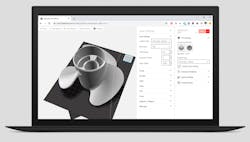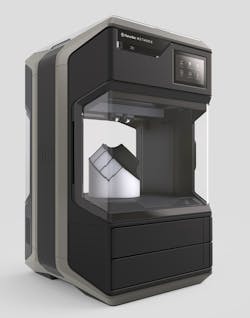Additive Manufacturing Qualification & Certification During Crises
On Aug. 19, MakerBot hosted a roundtable discussion in which Nadav Goshen, CEO of MakerBot, Stefanie Brickwede, managing director of Mobility goes Additive and Chris Connery, VP, Global Research and Analysis at CONTEXT discussed additive manufacturing (AM) and where it’s going from here.
Amid the COVID-19 pandemic, there is no question that AM has been able to fill the gap in traditional supply chains that were severed by global shutdowns. But will that surge in AM continue in a post-COVID world? That question was posed many different ways during the discussion.
Goshen spoke on two different movements of additive that have evolved from the pandemic: supply chain revolution and collaboration.
“One [movement] is on supply chain,” he said. “The vulnerability of manufacturers is something we need to address.”
The other movement, Goshen said, is in the workplace. With new mandates that require people to stay at home, communication between people is also changing.
“New tools have to come into play when you are working remotely,” he said. “We see a spike in demand from companies that still want to continue engineering while working remotely.”
Goshen believes the pandemic will cause remote collaborative teams to become more prominent even after the pandemic is over. Brickwede agreed and added that COVID enabled the world to take notice of additive technology.
“I’m absolutely convinced that Corona…we were definitely not looking for that,” she said. “It really helped because many companies, especially the smaller ones, are really thinking: ‘This new technology—we should really try it out.’”
Brickwede used automotive suppliers as an example of industry diversity. Before COVID-19, an automotive supplier wouldn’t have typically considered supplying to the medical industry. Now, it is uncommon if large suppliers aren’t working across industry verticals.
The supply chain shift isn’t the only thing that’s boosted additive manufacturing thus far in 2020. 3D printing manufacturers found themselves not just selling, but also printing.
“In Q1 and the better part of Q2, we saw that 3D printer manufacturers themselves became service providers,” said Connery. “Which really helped showcase the flexibility of additive manufacturing.”
Of course, even more reluctance to enter the AM market revolves around capital expenditures for the machinery. While industrial printers hold the bulk of revenue, they sell the fewest units.
“What our forecasts anticipate,” said Connery, “is the demand that we’ve seen on the professional [unit] side can translate—once capital expenditure purse strings become a little open—to then begin to step up to a higher-level machine.”
Another topic up for discussion was the issue of standards, quality and certification. AM is a young industry, so standards are slow and fluid—always changing. But when the shortage of PPE emerged, certifications (while important) were not the top priority for some OEMs and manufacturers.
“In times of need, people were innovative to fill the demand,” Goshen said. “There is a catch-up process…I think we see us, as an OEM, facilitating the discussion between the regulatory authority, material providers and us as OEMs.”
Brickwede, who works at a consortium of industrial partners, had a different view on certification and quality as it related to demand.
“If you want to bring spare parts into a train, no matter if they’re made from metal or plastics, they have to fulfill certain quality levels,” she said. “When you need, for example, a certain level of flame retardance, you have to prove that first.”
Brickwede said that people did want to help with the shortage of PPE, but they still had to learn that even during a crisis, they had to achieve and prove specific qualifications.
“It really helped to make people more sensitive for such items, which is definitely crucial if you want to be an industrial partner,” she said.
One thing seemed to resonate with all three speakers—the market for 3D printing is building because of a global crisis that brought society together.
About the Author

Marie Darty
Group Multimedia Director, Engineering & Manufacturing
Marie Darty is a digital media professional currently serving as the group multimedia director for the Manufacturing & Engineering Group at Endeavor Business Media. A graduate of Jacksonville State University, she earned her Bachelor of Arts in digital communication with a concentration in digital journalism in December 2016. In her current role, she leads the strategy and production of multimedia content, overseeing video series planning and editing. Additionally, she oversees podcast production and marketing of multimedia content.





